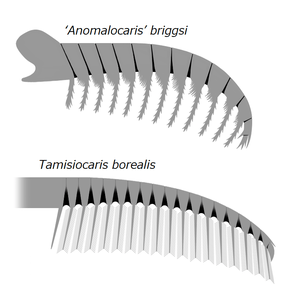Cetiocaridae
Cetiocaridae is a clade of radiodont, an extinct stem-group arthropods. The group was named after the Bearded Ceticaris (Cetimimus barbus)[1] in the speculative paleoart book All Your Yesterdays by John Meszaros.[2] In later studies the group was renamed as a radiodont family Tamisiocarididae.[3][4]
| Cetiocaridae | |
|---|---|
 | |
| Frontal appendages of Anomalocaris briggsi and Tamisiocaris borealis | |
| Scientific classification | |
| Kingdom: | Animalia |
| Phylum: | Arthropoda |
| Class: | †Dinocaridida |
| Order: | †Radiodonta |
| Suborder: | †Anomalocarida |
| Clade: | †Cetiocaridae Vinther et al., 2014 |
Description
Like most radiodonts, cetiocarids have spiny frontal appendages, but in this family the auxiliary spines are fine and densely-arranged, which are modified for use in filter feeding like modern basking sharks and mysticete whales. For example, Tamisocaris is estimated to have fed on prey roughly a millimeter in size.[5]
Classification
Cetiocaridae is defined phylogenetically as all species more closely related to Tamisiocaris borealis than to Anomalocaris canadensis, Amplectobelua symbrachiata, or Hurdia victoria. Morphologically, the clade is diagnosed by having long, slender, recurved ventral spines on the frontal appendages possessing numerous auxiliary spines on both sides.[5]
| Radiodonta |
| ||||||||||||||||||||||||
References
- "Bearded Ceticaris by NocturnalSea on DeviantArt". www.deviantart.com. Retrieved 2020-02-18.
- Kosemen CM (2013). All Your Yesterdays. Irregular Books. p. 74.
- Lerosey-Aubril R, Pates S (September 2018). "New suspension-feeding radiodont suggests evolution of microplanktivory in Cambrian macronekton". Nature Communications. 9 (1): 3774. doi:10.1038/s41467-018-06229-7. PMID 30218075.
- Pates S, Daley AC, Butterfield NJ (2019-06-11). "First report of paired ventral endites in a hurdiid radiodont". Zoological Letters. 5 (1): 18. doi:10.1186/s40851-019-0132-4. PMC 6560863. PMID 31210962.
- Vinther J, Stein M, Longrich NR, Harper DA (March 2014). "A suspension-feeding anomalocarid from the Early Cambrian" (PDF). Nature. 507 (7493): 496–9. doi:10.1038/nature13010. PMID 24670770.